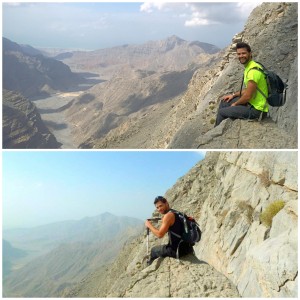Hiking denotes a different activity in different places. For example, in North America, it refers to walking long distances on marked paths in nature. In other regions, such as the Middle East, it suggests going on a hike of any duration.
Usually lasting for a full day, hiking involves treading known trails with minimal planning and gear. Unlike trekking, hiking is often self-supported and non-commercial, read this hiking story, it is one of my favorite hikes in Oman.

On the other hand, although similar, trekking always involves walking in nature through difficult terrain for several days. Along the trek’s path, you usually find villages and guest houses that you can rely on for shelter, food, and water. Read this trekking story that I did with my family.
Often, trekking represents the commercial aspect of walking in nature, in which tour operators guide trekkers through long trails.

I do it cause I can blog will use the term “hiking” for all nature walks lasting 1 to 3 days (including backpacking and camping in between). And will use the term “trekking” for all nature walks that are more than 3 days, which are either guide & porter supported or self-supported treks.
Typical Hiking & Trekking Gear Includes (but not limited to):
One-day Hike:
- Hiking backpack (usually 20L to 35L)
- Hiking shoes (could also be your sports shoes as long as you get good ankle support)
- Hiking poles
- Hiking clothes (could also be sportswear, depending on the weather)
- Food & water (hydration is crucial, on average, a person should consume 4.5L a day when hiking)
- First aid kit (First aid kits should be custumized based on the area you are going to)
- Lighter, a 3m length of 1.5mm cord, emergency blanket
- Map & compass
Multiple-day Hike (in addition to one-day gear):
- Sleeping mat
- Sleeping bag (depending on the weather)
- Tent
- Portable stove
Trekking gear:
- Trekking backpack (usually 45L +)
- Trekking shoes (could be hiking shoes, but make sure they are super comfortable)
- Trekking poles (same as hiking poles)
- Trekking clothes (you have to pack enough clothes based on how many days your trek is)
- Snacks & water for the day (often breakfasts and dinners are offered by guest houses along the way)
- First aid kit (First aid kits should be custumized based on the area you are going to)
- Lighter, 3m length of 1.5mm cord & emergency blanket
- Map & compass
- Sleeping mat
- Sleeping bag (depends on the weather and if indoor accommodation is available along the way)
- Tent (if you are not staying in guest houses)
Why hike & trekk?
In my experience, hiking is the most rewarding outdoor activity. It connects you with nature on many levels. If you seek peace and refuge away from civilization, definitely try hiking!
Hiking is a great disconnect for a day but I believe it is always a shallow disconnect. On the other hand, trekking is one of the best ways to experience a culture, explore indigenous civilization, and discover unspoiled wilderness while could be with a total disconnect from your reality.
Related blogs:











One Response